Dynamic Changes, Spatiotemporal Differences and Factors Influencing the Urban Eco-Efficiency in the Lower Reaches of the Yellow River
Abstract
1. Introduction
2. Materials and Methods
2.1. Study Area
2.2. Indicator Syste
2.2.1. Input Index
2.2.2. Output Index
2.3. Research Method
2.3.1. Urban Carbon Emission Estimation
2.3.2. Super-SBM Model Based on Undesirable Output
2.3.3. Standard Deviation Ellipse
2.3.4. STIRPAT Model
3. Results
3.1. Spatiotemporal Variation of the Urban Eco-Efficiency in the Lower Reaches of the Yellow River
3.1.1. Temporal Changes in the Urban Eco-Efficiency in the Lower Reaches of the Yellow River
3.1.2. Spatial Differentiation of the Urban Eco-Efficiency in the Lower Reaches of the Yellow River
3.2. Driving Mechanism of the Urban Eco-Efficiency in the Lower Reaches of the Yellow River
3.2.1. Selection of Impact Indicators
3.2.2. Analysis of the Driving Mechanism
4. Discussion
5. Conclusions
- (1)
- Changing the mode of economic development and promoting high-quality development of urban economy is the theme of urban sustainable development in the lower reaches of the Yellow River. At the same time, we should take the improvement of urban eco-efficiency as an important part of government work, and change the traditional single GDP-oriented development model in order to release the space and potential of urban green development and promote urban sustainable development.
- (2)
- Although the gap of urban eco-efficiency between Shandong Province and Henan Province in the lower reaches of the Yellow River has been alleviated in recent years, we should still pay attention to the coordinated development between regions. The areas with high efficiency should give full play to the positive spillover effect and encourage the flow of advanced technology and industry to promote the coordinated development of cities in the river basin.
- (3)
- The local government of the study area should pay attention to the optimization and upgrading of industrial structure and the adjustment of energy utilization structure. By reducing the proportion of fossil fuels and energy consumption per unit of GDP, the government should strive to ensure high-quality urban economic development, let people enjoy more benefits brought about by high-quality development, and improve people’s living standards.
- (4)
- At present, urban eco-efficiency in the lower reaches of the Yellow River has been restricted by an extensive investment-driven model, and high pollution an inefficient industrial structure, and a foreign investment model with high pollution risk. Therefore, the local government should strictly abide by the environmental protection policies and regulations issued by the central government; issue and implement the “three lines and one order” as soon as possible; and build regional cooperation mechanisms for resource conservation and eco-environmental protection, as well as formulate energy conservation and emission reduction policies from a regional and urban perspective. We should give full play to the government’s “visible hand” and improve the access standards of enterprises, as well as promote high-quality development of the regional economy and society with high-level protection of the ecological environment. At the same time, we should give full play to the leading role of Zhengzhou and Jinan as national central cities, speed up the construction of the Zhongyuan urban agglomeration and the Shandong Peninsula urban agglomeration, optimize the industrial layout, and form a joint force for development. Finally, cities should avoid inefficient industries and pay attention to the introduction of high-tech industries; seize the strategic opportunities of 5G, Internet +, and block chain; increase support for local emerging industries; adjust measures to local conditions; and develop local characteristic industries so as to optimize and adjust traditional leading industries and promote urban transformation and development.
Author Contributions
Funding
Conflicts of Interest
References
- Lin, B.Q.; Zhu, J.P. Changes in urban air quality during urbanization in China. J. Clean. Prod. 2018, 218, 312–321. [Google Scholar] [CrossRef]
- Gudipudi, R.; Lüdeke, M.K.B.; Rybski, D.; Kropp, J.P. Benchmarking urban eco-efficiency and urbanites’ perception. Cities 2018, 74, 109–118. [Google Scholar] [CrossRef]
- Grimm, N.B.; Faeth, S.H.; Golubiewski, N.E.; Redman, C.L.; Wu, J.G.; Bai, X.M.; Briggs, J.M. Global change and the ecology of cities. Science 2008, 319, 756–760. [Google Scholar] [CrossRef]
- Zhao, Y.B.; Wang, S.J.; Ge, Y.J.; Liu, Q.Q.; Liu, X.F. The spatial differentiation of the coupling relationship between urbanization and the eco-environment in countries globally: A comprehensive assessment. Ecol. Model. 2017, 360, 313–327. [Google Scholar] [CrossRef]
- Zhang, W.; Villarini, G.; Vecchi, G.A.; Smith, J.A. Urbanization exacerbated the rainfall and flooding caused by hurricane Harvey in Houston. Nature 2018, 563, 384–388. [Google Scholar] [CrossRef] [PubMed]
- Lu, Y.L.; Zhang, Y.Q.; Cao, X.H.; Wang, C.C.; Wang, Y.C.; Zhang, M.; Ferrier, R.C.; Jenkins, A.; Yuan, J.J.; Bailey, M.J.; et al. Forty years of reform and opening up: China’s progress toward a sustainable path. Sci. Adv. 2019, 5, 9413. [Google Scholar] [CrossRef]
- Liu, N.N.; Liu, C.Z.; Xia, Y.F.; Da, B.W. Examining the coordination between urbanization and eco-environment using coupling and spatial analyses: A case study in China. Ecol. Indic. 2018, 93, 1163–1175. [Google Scholar] [CrossRef]
- Yang, H.R.; Wu, Q. Land use eco-efficiency and its convergence characteristics under the constraint of carbon emissions in China. Int. J. Environ. Res. Public Health 2019, 16, 3172. [Google Scholar] [CrossRef]
- Liu, Q.Q.; Wang, S.J.; Li, B.; Zhang, W.Z. Dynamics, differences, influencing factors of eco-efficiency in China: A spatiotemporal perspective analysis. J. Environ. Manag. 2020, 264, 110442. [Google Scholar] [CrossRef]
- Geng, Y.; Sarkis, J.; Zhang, P. Measuring China’s circular economy. Science 2013, 339, 1526–1527. [Google Scholar] [CrossRef]
- Wang, S.J.; Wang, J.Y.; Zhou, Y.Q. Estimating the effects of socioeconomic structure on CO2 emissions in China using an econometric analysis framework. Struct. Chang. Econ. Dyn. 2018, 47, 18–27. [Google Scholar] [CrossRef]
- Ramaswami, A.; Russell, A.G.; Culligan, P.J.; Sharma, K.R.S.; Kumar, E. Meta-Principles for developing smart, sustainable, and healthy cities. Science 2016, 352, 940–943. [Google Scholar] [CrossRef] [PubMed]
- Lim, Y.; Edelenbos, J.; Gianoli, A. Identifying the results of smart city development: Findings from systematic literature review. Cities 2019, 95, 102397. [Google Scholar] [CrossRef]
- Willard, B. The Sustainability Advantage: Seven Business Case Benefits of a Triple Bottom Line; New Society Publishers: Gabriola Island, BC, Canada, 2002. [Google Scholar]
- Ren, Y.F.; Fang, C.L. Spatial pattern and evaluation of eco-efficiency in counties of the Beijing-Tianjin-Hebei Urban Agglomeration. Prog. Geogr. 2017, 36, 87–98. (In Chinese) [Google Scholar]
- Yin, K.; Wang, R.S.; An, Q.X.; Yao, L.; Liang, J. Using eco-efficiency as an indicator for sustainable urban development: A case study of Chinese provincial capital cities. Ecol. Indic. 2014, 36, 665–671. [Google Scholar] [CrossRef]
- Kicherer, A.; Schaltegger, S.; Tschochohei, H.; Pozo, B.F. Eco-Efficiency. Int. J. Life Cycle Assess. 2007, 12, 537. [Google Scholar]
- WBCSD. Eco-Efficient Leadership for Improved Economic and Environmental Performance; WBCSD: Geneva, Switzerland, 1996. [Google Scholar]
- Huang, Y.; Li, L.; Yu, Y.T. Does urban cluster promote the increase of urban eco-efficiency? Evidence from Chinese cities. J. Clean. Prod. 2018, 197, 957–971. [Google Scholar] [CrossRef]
- Kaklauskas, A.; Zavadskas, E.K.; Radzeviciene, A.; Ubarte, I.; Podviezko, A.; Podvezko, V.; Kuzminske, A.; Banaitis, A.; Binkyte, A.; Bucinskas, V. Quality of city life multiple criteria analysis. Cities 2018, 72, 82–93. [Google Scholar] [CrossRef]
- Dong, F.; Zhang, Y.Q.; Zhang, X.Y. Applying a data envelopment analysis game cross efficiency model to examining regional ecological efficiency: Evidence from China. J. Clean. Prod. 2020, 267, 122031. [Google Scholar] [CrossRef]
- Moutinho, V.; Madaleno, M.; Macedo, P. The effect of urban air pollutants in Germany: Eco-Efficiency analysis through fractional regression models applied after DEA and SFA efficiency predictions. Sustain. Cities Soc. 2020, 59, 102204. [Google Scholar] [CrossRef]
- Shi, K.F.; Yu, B.L.; Zhou, Y.Y.; Yang, C.S.; Chen, Z.Q.; Wu, J.P. Spatiotemporal variations of CO2 emissions and their impact factors in China: A comparative analysis between the provincial and prefectural levels. Appl. Energy 2019, 233, 170–181. [Google Scholar] [CrossRef]
- Gabisa, E.W.; Gheewala, S.H. Can substitution of imported gasoline by locally produced molasses ethanol in Ethiopia be sustainable? An eco-efficiency assessment. Renew. Sustain. Energy Rev. 2020, 123, 109770. [Google Scholar] [CrossRef]
- Lin, Y.; Yang, Y.T. Evaluation of eco-efficiency in China from 1978 to 2016: Based on a modified ecological footprint model. Sci. Total Environ. 2019, 662, 581–590. [Google Scholar]
- Song, J.F.; Chen, X.N. Eco-Efficiency of grain production in China based on water footprints: A stochastic frontier approach. J. Clean. Prod. 2019, 236, 117685. [Google Scholar] [CrossRef]
- Huang, J.H.; Xia, J.J.; Yu, Y.T.; Zhang, N. Composite eco-efficiency indicators for China based on data envelopment analysis. Ecol. Indic. 2018, 85, 674–697. [Google Scholar] [CrossRef]
- Zhang, P.Y.; He, J.J.; Hong, X.; Zhang, W.; Qin, C.Z.; Pang, B.; Li, Y.Y.; Liu, X. Carbon sources/sinks analysis of land use changes in China based on data envelopment analysis. J. Clean. Prod. 2018, 204, 702–711. [Google Scholar] [CrossRef]
- Li, Z.; Ouyang, X.L.; Du, K.; Zhao, Y. Does government transparency contribute to improved eco-efficiency performance? An empirical study of 262 cities in China. Energy Policy 2017, 110, 79–89. [Google Scholar] [CrossRef]
- Yang, H.R.; Zheng, H.; Liu, H.G.; Wu, Q. NonLinear effects of environmental regulation on eco-efficiency under the constraint of land use carbon emissions: Evidence based on a Bootstrapping approach and Panel Threshold Model. Int. J. Environ. Res. Public Health 2019, 16, 1679. [Google Scholar] [CrossRef]
- Ren, Y.F.; Fang, C.L.; Li, G.D. Spatiotemporal characteristics and influential factors of eco-efficiency in Chinese prefecture-level cities: A spatial panel econometric analysis. J. Clean. Prod. 2020, 260, 120787. [Google Scholar] [CrossRef]
- Yang, L.; Zhang, X. Assessing regional eco-efficiency from the perspective of resource, environmental and economic performance in China: A bootstrapping approach in global data envelopment analysis. J. Clean. Prod. 2018, 173, 100–111. [Google Scholar] [CrossRef]
- Tone, K. A slacks-based measure of efficiency in data envelopment analysis. Eur. J. Oper. Res. 2001, 130, 498–509. [Google Scholar] [CrossRef]
- Huang, J.H.; Yang, X.G.; Cheng, G.; Wang, S.Y. A comprehensive eco-efficiency model and dynamics of regional eco-efficiency in China. J. Clean. Prod. 2014, 67, 228–238. [Google Scholar] [CrossRef]
- Tone, K. A slacks-based measure of super-efficiency in data envelopment analysis. Eur. J. Oper. Res. 2002, 143, 32–41. [Google Scholar] [CrossRef]
- York, R.; Rosa, E.A.; Dietz, T. STIRPAT, IPAT and ImPACT: Analytic tools for unpacking the driving forces of environmental impact. Ecol. Econ. 2003, 46, 351–365. [Google Scholar] [CrossRef]
- Wang, P.; Zhu, W.S.; Zhu, B.Z.; Wang, Y.M. Examining the impact factors of energy-related CO2 emissions using the STIRPAT model in Guangdong Province, China. Appl. Energy 2013, 106, 65–71. [Google Scholar] [CrossRef]
- Liu, Y.Q.; Zhu, J.L.; Li, E.Y.; Meng, Z.Y.; Song, Y. Environmental regulation, green technological innovation, and eco-efficiency: The case of Yangtze river economic belt in China. Technol. Forecast. Soc. Chang. 2020, 155, 119993. [Google Scholar] [CrossRef]
- Zhang, P.Y.; Zhang, Y.; Li, J.; Li, Y.Y.; Yang, J.Y.; Geng, W.L.; Liu, Y.; Rong, T.Q.; Shao, J.W.; Li, B. Characteristics of the spatio-temporal trends and driving factors of industrial development and industrial SO2 emissions based on Niche theory: Taking Henan Province as an example. Sustainability 2020, 12, 1389. [Google Scholar] [CrossRef]
- Wang, L.J.; Yao, L.; Zhao, X.D.; Zhang, P.Y.; Liu, Y.X.Y.; Xia, X.L.; Song, J.; Yang, J.; Li, Y.; Zhou, C.H. Understanding terrestrial water storage declining trends in the Yellow river Basin. J. Geophys. Res. Atmos. 2019, 124, 12963–12984. [Google Scholar]
- Zhang, P.Y.; Qin, C.Z.; Hong, X.; Kang, G.H.; Qin, M.Z.; Yang, D.; Pang, B.; Li, Y.Y.; He, J.J.; Dick, R.P. Risk assessment and source analysis of soil heavy metal pollution from lower reaches of Yellow River irrigation in China. Sci. Total Environ. 2018, 633, 1136–1147. [Google Scholar] [CrossRef]
- Wei, T.Y. What STIRPAT tells about effects of population and affluence on the environment? Ecol. Econ. 2011, 72, 70–74. [Google Scholar] [CrossRef]
- Rong, T.Q.; Zhang, P.Y.; Wang, L.J.; Zhang, Y.; Li, Y.; Yang, D.; Yang, J.X.; Chang, H.; Ge, L. Carbon dioxide emissions and their driving forces of land use change based on Economic Contributive Coefficient (ECC) and Ecological Support Coefficient (ESC) in the lower Yellow river region (1995–2018). Energies 2020, 13, 2600. [Google Scholar] [CrossRef]
- Cen, Y.F.; Zhang, P.Y.; Yan, Y.H.; Wang, L.J.; Zhang, Y.; Li, Y.Y.; Yang, D.; Geng, W.L.; Rong, T.Q. Spatial and temporal agglomeration characteristics and coupling relationship of urban built-up land and economic hinterland—A case study of the lower Yellow river, China. Sustainability 2019, 11, 5218. [Google Scholar] [CrossRef]
- Zhang, B.F.; Miao, C.H. Spatiotemporal changes and driving forces of land use in the Yellow River Basin. Resour. Sci. 2020, 42, 460–473. (In Chinese) [Google Scholar] [CrossRef]
- China Economic and Social Big Data Research Platform. Available online: https://data.cnki.net/ (accessed on 27 June 2020). (In Chinese).
- Fang, C.L.; Guan, X.L. Comprehensive Measurement and spatial distinction of input-output efficiency of urban agglomerations in China. Acta Geogr. Sin. 2011, 66, 1011–1022. (In Chinese) [Google Scholar]
- Hall, R.E.; Jones, C.I. Why do some countries produce so much more output per worker than others? Q. J. Econ. 1999, 144, 83–116. [Google Scholar] [CrossRef]
- Zhu, Q.X.; Mei, J.; Chen, Y.R.; Han, X. Regional differentiation characteristics and optimization of the structural efficiency of land use in Hubei province based on the carbon emissions. Econ. Geogr. 2015, 35, 176–184. (In Chinese) [Google Scholar]
- Wang, X.E.; Wang, Y.X.; Duan, H.Y. Forecasting area’s carbon emissions of energy consumption and controllability study. China Population. Resour. Environ. 2014, 24, 9–16. (In Chinese) [Google Scholar]
- Zhang, M.; Gan, C.L.; Chen, Y.R.; Chen, L. Carbon emission efficiency and optimization of low carbon for construction land development intensity in China according to provincial panel data. Resour. Sci. 2016, 38, 265–275. (In Chinese) [Google Scholar]
- Charnes, A.; Cooper, W.W.; Rhodes, E. Measuring the efficiency of decision making units. Eur. J. Oper. Res. 1978, 2, 429–444. [Google Scholar] [CrossRef]
- Yu, J.Q.; Zhou, K.L.; Yang, S.L. Regional heterogeneity of China’s energy efficiency in “new normal”: A meta-frontier Super-SBM analysis. Energy Policy 2019, 134, 110941. [Google Scholar] [CrossRef]
- Lefever, D.W. Measuring geographic concentration by means of the Standard Deviational Ellipse. Am. J. Sociol. 1926, 32, 88–94. [Google Scholar] [CrossRef]
- He, S.W.; Wang, W.W.; Zeng, C.; Liu, M.H. Spatio-Temporal pattern of economic development and the forecast in China. Acta Geogr. Sin. 2016, 36, 1622–1628. (In Chinese) [Google Scholar]
- Xu, X.; Zhao, Y.; Zhang, X.L.; Zhang, X.G. Spatial variation of population aging and associated factors in Jiangsu Province. Acta Geogr. Sin. 2017, 37, 1859–1866. (In Chinese) [Google Scholar]
- Zheng, D.F.; Hao, S.; Sun, C.Z.; Lu, L.T. Spatio-Temporal pattern evolution of eco-efficiency and the forecast in mainland of China. Geogr. Res. 2018, 37, 1034–1046. (In Chinese) [Google Scholar]
- Xia, H.; Zhang, W.S.; Wang, H.; Peng, H.; Zhang, Z.Q.; Ke, Q.; Bu, S.F. Spatial-Temporal patterns and characteristics of ecological function between 2009 and 2015 in China. Ecol. Indic. 2020, 116, 106478. [Google Scholar] [CrossRef]
- Ehrlich, P.R.; Holden, J.P. Impact of population growth. Science 1971, 171, 1212–1217. [Google Scholar] [CrossRef]
- Dietz, T.; Rosa, E.A. Rethinking the environmental impacts of population, affluence and technology. Hum. Ecol. Rev. 1994, 2, 277–300. [Google Scholar]
- Ehrlich, P.R.; Holden, J.P. One-Dimensional economy. Bull. At. Sci. 1972, 28, 16–27. [Google Scholar] [CrossRef]
- Wang, S.J.; Gao, S.; Huang, Y.Y.; Shi, C.Y. Spatio-Temporal evolution and trend prediction of urban carbon emission performance in China based on super-efficiency SBM model. Acta Geogr. Sin. 2020, 75, 1316–1330. (In Chinese) [Google Scholar]
- Zhang, P.Y.; Yang, D.; Zhang, Y.; Li, Y.Y.; Liu, Y.; Cen, Y.F.; Zhang, W.; Geng, W.L.; Rong, T.Q.; Liu, Y.; et al. Re-examining the drive forces of China’s industrial wastewater pollution based on GWR model at provincial level. J. Clean. Prod. 2020, 262, 121309. [Google Scholar] [CrossRef]
- Cui, X.G.; Fang, C.L.; Liu, H.M.; Liu, F.X. Assessing sustainability of urbanization by a coordinated development index for an Urbanization-Resources-Environment complex system: A case study of Jing-Jin-Ji region, China. Ecol. Indic. 2019, 96, 383–391. [Google Scholar] [CrossRef]
- Xu, H.; Shi, N.; Wu, L.L.; Zhang, D.W. High-Quality development level and its spatiotemporal changes in the Yellow River Basin. Resour. Sci. 2020, 42, 115–126. (In Chinese) [Google Scholar]
- Ma, H.T.; Xu, X.F. High-Quality development assessment and spatial heterogeneity of urban agglomeration in the Yellow River Basin. Econ. Geogr. 2020, 40, 11–18. (In Chinese) [Google Scholar]
- Ren, W.Z.; Zhang, Z.L.; Wang, Y.J.; Xue, B.; Chen, X.P. Measuring regional eco-efficiency in China (2003–2016): A “Full World” perspective and network data envelopment analysis. Int. J. Environ. Res. Public Health 2020, 17, 3456. [Google Scholar] [CrossRef]
- Wang, Y.; Chen, X.Y. Natural resource endowment and ecological efficiency in China: Revisiting resource curse in the context of ecological efficiency. Resour. Policy 2020, 66, 101610. [Google Scholar] [CrossRef]
- Lin, B.Q.; Zhu, J.P. Impact of energy saving and emission reduction policy on urban sustainable development: Empirical evidence from China. Appl. Energy 2019, 239, 12–22. [Google Scholar] [CrossRef]
- Zhou, C.S.; Shi, C.Y.; Wang, S.J.; Zhang, G.J. Estimation of eco-efficiency and its influencing factors in Guangdong province based on Super-SBM and panel regression models. Ecol. Indic. 2018, 86, 67–80. [Google Scholar] [CrossRef]
- Cheng, Y.Y.; Shao, T.Y.; Lai, H.L.; Shen, M.H.; Li, Y. Total-Factor eco-efficiency and its influencing factors in the Yangtze River Delta urban agglomeration, China. Int. J. Environ. Res. Public Health 2019, 16, 3814. [Google Scholar] [CrossRef]
- Cui, P.P.; Zhao, Y.; Xia, S.Y.; Yan, J.Y. Level measures and temporal and spatial coupling analysis of ecological environment and high quality development in the Yellow River Basin. Econ. Geogr. 2020, 40, 49–57. (In Chinese) [Google Scholar]
- Qin, X.H.; Sun, Y.M. Cross-Regional comparative study on environmental–economic efficiency and driving forces behind efficiency improvement in China: A multistage perspective. Int. J. Environ. Res. Public Health 2019, 16, 1160. [Google Scholar] [CrossRef]
- Shi, L.P.; Cai, Z.Y.; Ding, X.H.; Di, R.; Xiao, Q.Q. What factors affect the level of green urbanization in the Yellow River Basin in the context of new-type urbanization? Sustainability 2020, 12, 2488. [Google Scholar] [CrossRef]
- Zhang, P.Y.; Li, Y.Y.; Jing, W.L.; Yang, D.; Zhang, Y.; Liu, Y.; Geng, W.L.; Rong, T.Q.; Shao, J.W.; Yang, J.X.; et al. Comprehensive Assessment of the Effect of Urban Built-up Land Expansion and Climate Change on Net Primary Productivity. Complexity 2020. [Google Scholar] [CrossRef]
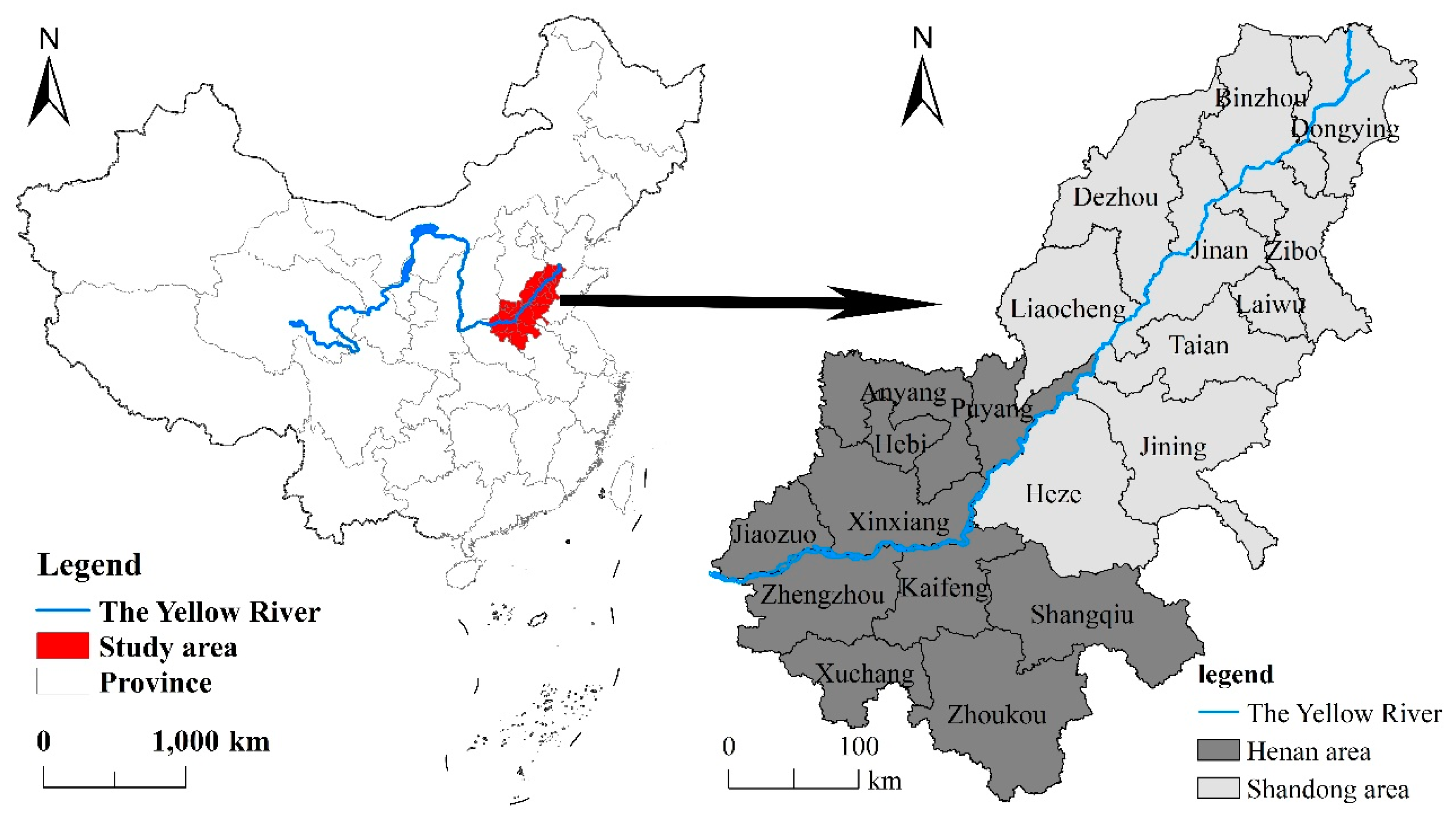
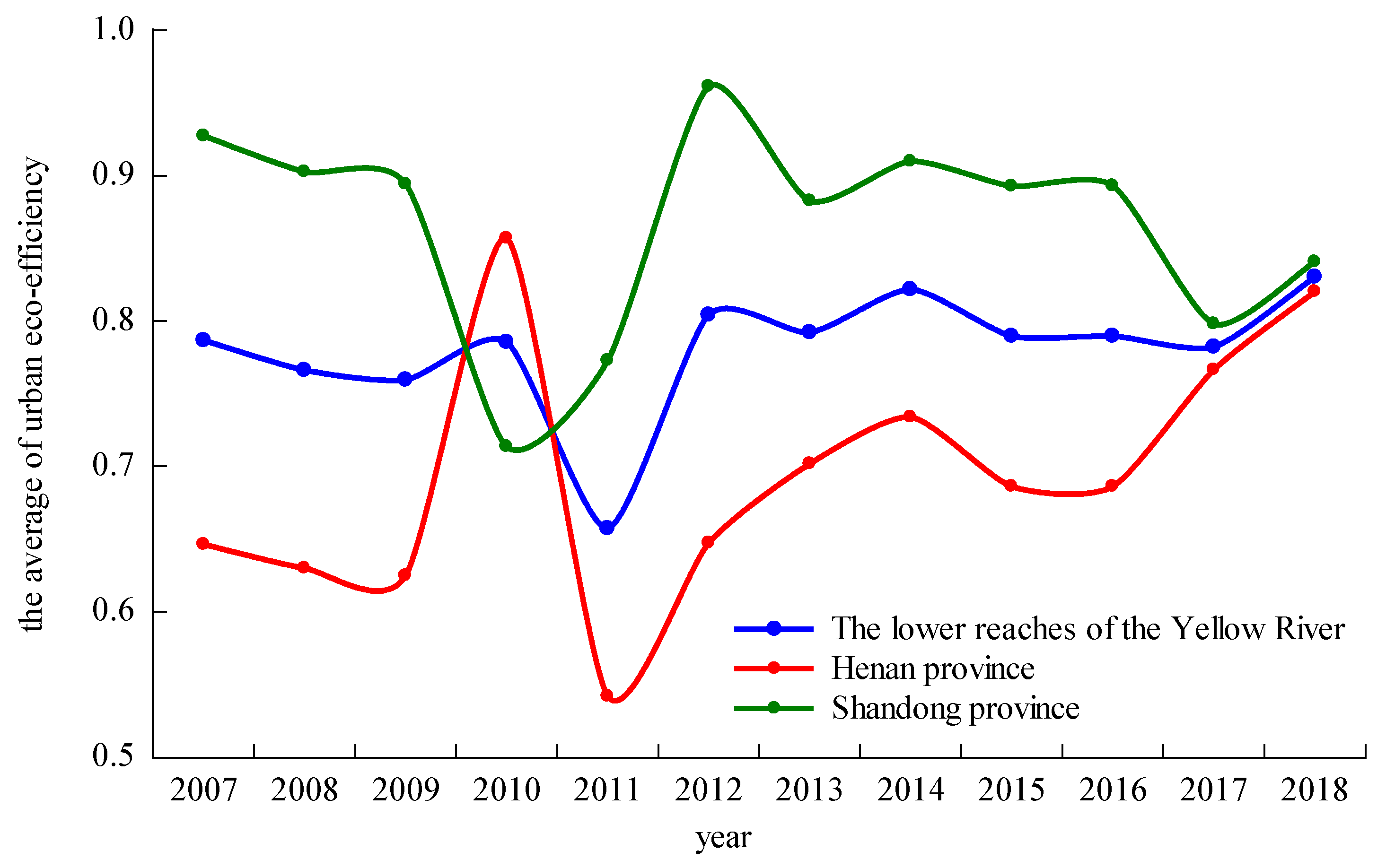
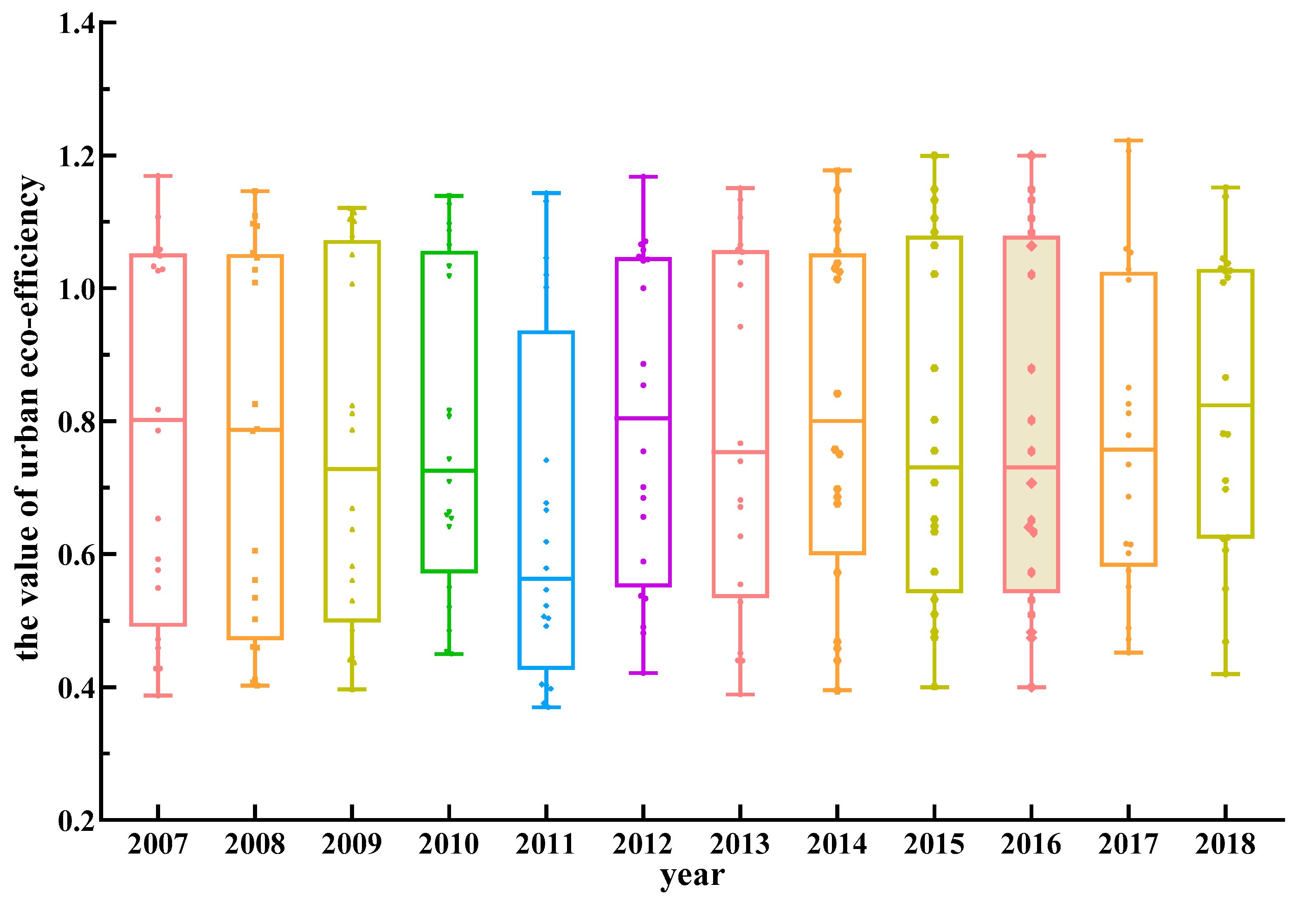
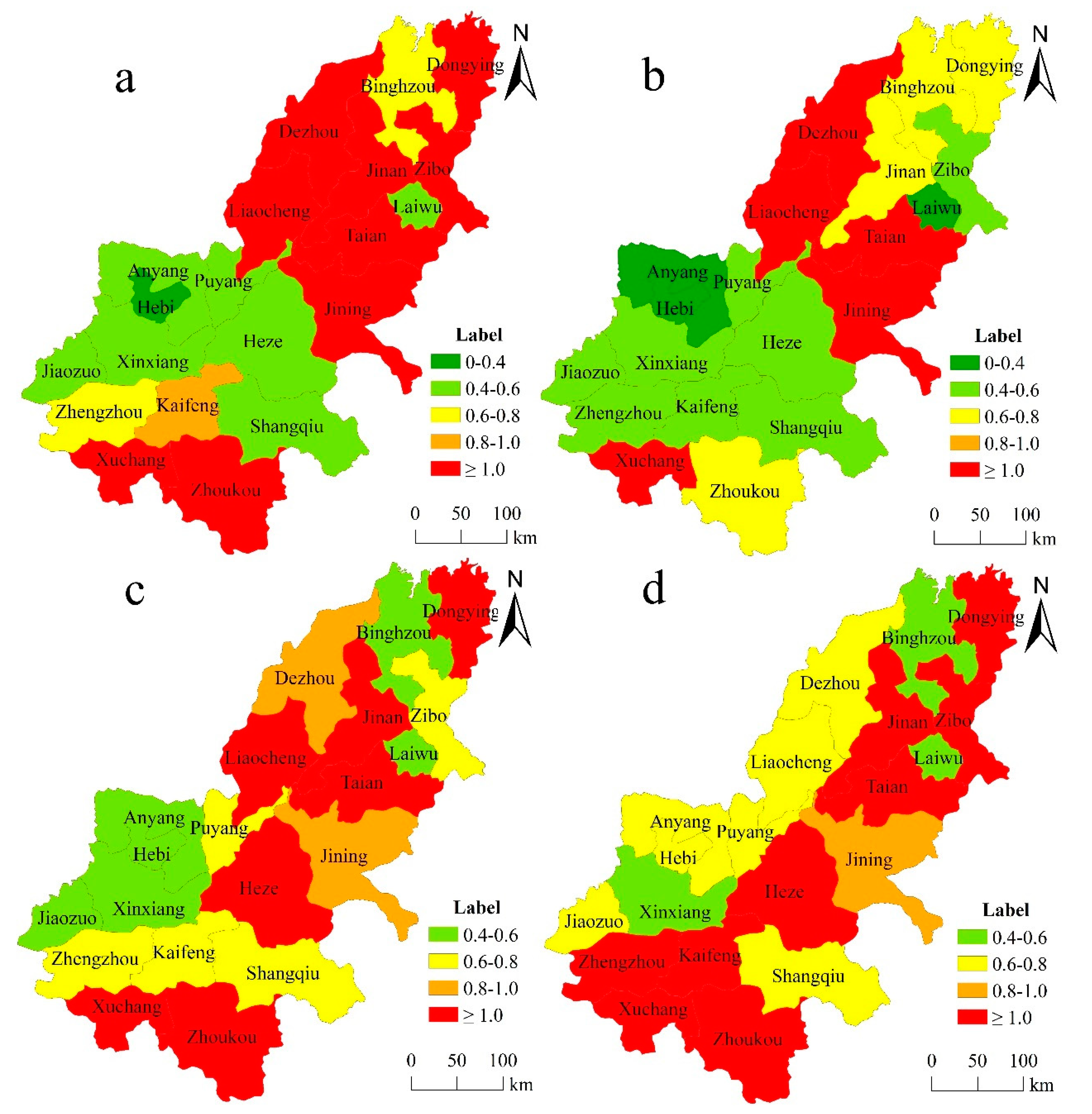
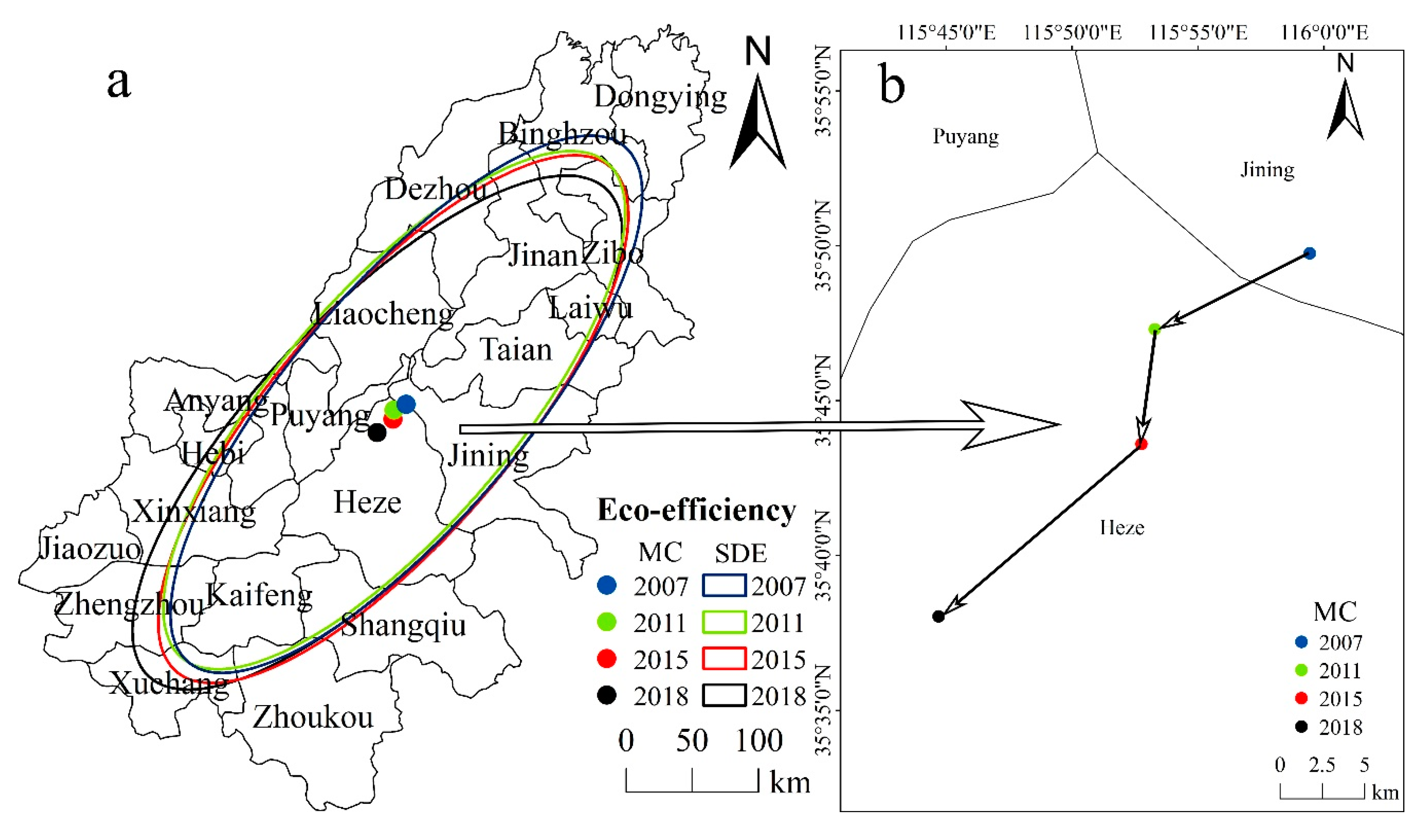
| Category | Variable | Units | Mean | Standard Deviation (SD) | Minimum | Maximum |
|---|---|---|---|---|---|---|
| Input | Labor force | 104 people | 57.109 | 36.032 | 13.27 | 207.555 |
| Capital | 104 yuan | 6608.376 | 6480.381 | 165.322 | 42,605.902 | |
| Energy resource | 108 tons of standard coal equivalent | 184.698 | 192.969 | 12.268 | 1581.735 | |
| Desirable output | Gross Domestic Product | 109 yuan | 1156.283 | 676.978 | 266 | 3868.797 |
| Undesirable output | Total wastewater emission | 104 tons | 10,546.359 | 7273.71 | 766 | 66,452 |
| Industrial SO2 emission | ton | 61,986.833 | 42,586.623 | 917 | 219,273 | |
| Industrial soot emission | ton | 29,395.089 | 30,861.296 | 775 | 236,000 | |
| CO2 emission | ton | 2920.640 | 1869.933 | 678.514 | 9998.306 |
| Year | The Standard Deviation along the Short Axis (km) | The Standard Deviation along the Long Axis (km) | Azimuth |
|---|---|---|---|
| 2007 | 88.658 | 255.235 | 40.27 |
| 2011 | 89.222 | 246.574 | 40.723 |
| 2015 | 89.671 | 251.485 | 40.738 |
| 2018 | 90.612 | 252.518 | 43.232 |
| Variable | Coefficient | Standard Error | t-Statistic | Probability | VIF |
|---|---|---|---|---|---|
| Constant | −0.143 | 0.070 | −2.047 | 0.042 ** | |
| Affluence | 0.220 | 0.033 | 6.584 | 0.000 *** | 1.423 |
| Investment intensity | −0.201 | 0.052 | −3.839 | 0.000 *** | 1.162 |
| Intensity of foreign investment | −0.102 | 0.017 | −5.863 | 0.000 *** | 1.182 |
| Industrial structure | −0.159 | 0.096 | −1.651 | 0.100 * | 1.941 |
| Technology progress | 0.522 | 0.046 | 11.391 | 0.000 *** | 1.939 |
| Population accumulation | −0.053 | 0.040 | −1.328 | 0.186 | 1.214 |
Publisher’s Note: MDPI stays neutral with regard to jurisdictional claims in published maps and institutional affiliations. |
© 2020 by the authors. Licensee MDPI, Basel, Switzerland. This article is an open access article distributed under the terms and conditions of the Creative Commons Attribution (CC BY) license (http://creativecommons.org/licenses/by/4.0/).
Share and Cite
Zhang, Y.; Geng, W.; Zhang, P.; Li, E.; Rong, T.; Liu, Y.; Shao, J.; Chang, H. Dynamic Changes, Spatiotemporal Differences and Factors Influencing the Urban Eco-Efficiency in the Lower Reaches of the Yellow River. Int. J. Environ. Res. Public Health 2020, 17, 7510. https://doi.org/10.3390/ijerph17207510
Zhang Y, Geng W, Zhang P, Li E, Rong T, Liu Y, Shao J, Chang H. Dynamic Changes, Spatiotemporal Differences and Factors Influencing the Urban Eco-Efficiency in the Lower Reaches of the Yellow River. International Journal of Environmental Research and Public Health. 2020; 17(20):7510. https://doi.org/10.3390/ijerph17207510
Chicago/Turabian StyleZhang, Yu, Wenliang Geng, Pengyan Zhang, Erling Li, Tianqi Rong, Ying Liu, Jingwen Shao, and Hao Chang. 2020. "Dynamic Changes, Spatiotemporal Differences and Factors Influencing the Urban Eco-Efficiency in the Lower Reaches of the Yellow River" International Journal of Environmental Research and Public Health 17, no. 20: 7510. https://doi.org/10.3390/ijerph17207510
APA StyleZhang, Y., Geng, W., Zhang, P., Li, E., Rong, T., Liu, Y., Shao, J., & Chang, H. (2020). Dynamic Changes, Spatiotemporal Differences and Factors Influencing the Urban Eco-Efficiency in the Lower Reaches of the Yellow River. International Journal of Environmental Research and Public Health, 17(20), 7510. https://doi.org/10.3390/ijerph17207510




